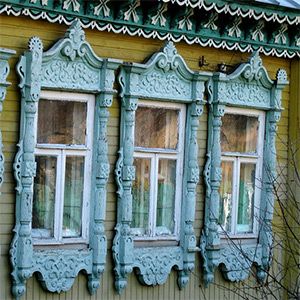Argunovo’s carving

Argunovo’s woodcarving, which goes back to the 18th century, glorified the carpentry of the Vladimir land. It was named so by the village of Argunovo, which was inhabited by skilful carpenters. Argunovo, which was the center of the volost (today does not exist), was located on the territory of the present Petushky district, in the middle reaches of the Kirzhach river. The main peasants’ occupation of the Argunovo volost was not farming, but carpentry. In the 19th century, thousands of Argunovo carpenters annually went for work to large cities, and were widely known outside their province – in Moscow, St. Petersburg, Yaroslavl, where they were called "arguns". In his famous dictionary V.I. Dal explains the word "argun" as "Vladimir carpenter".
According to some reports, the earl Sheremetyev’s serfs, talented artists and architects Argunovs, came from the Argunovo carpenters and worked at the end of the 18th century on decoration of palaces in Ostankino and Kuskovo near Moscow.
Artisans peasants-arguns from the Vladimir province specialized in making carved furniture (armchairs, tables, frames), carved church iconostases, slotted and flat patterned decor on the facades of urban wooden palaces and houses (cornices, platbands, towels). They were amazed by their skill to select small plates from different types of wood for a parquet floor, so that it would acquire intricate patterns.
Argunovo's carving was distinguished by an unusual variety of drawings and, most importantly, by the combination in the wooden decor of ancient pagan symbols of the sun and harvest, bereguinias and talismans, kind brownies and outlandish birds with human faces, fairy-tale dragons and mermaids – with antique columns and semicolumns, bunches of grapes and branches of the noble laurel. Carrying orders from metropolitan nobles and merchants, masters-carvers perceived elements of European classical culture, which organically combined in their artistic fantasies with ancient Russian images acquired from grandfathers and great-grandfathers. In addition, carved patterns of platbands and iconostasis were often painted using predominantly pastel and warm tones. This gave the decor a special beauty and sophistication.
Until the early 20th century, almost all the houses in the center of Kirzhach were decorated with Argunovo’s carving, giving them a festive look. Unfortunately, during the Soviet years, the Argunovo’s decor in many houses in Kirzhach was pretty dilapidated, and, in addition, according to new ideological approaches, recognized philistine, was dismantled and replaced with faceless new forms of platbands and eaves. But in the nearby villages – Fineevo, Ilinskoe, Nikiforovo, etc. – on the facades of old huts today you can still see the remains of the former luxury – delicate carved ornaments.
At the moment, there are few craftsmen who own the secrets of Argunovo's woodcarving. And yet this art is not lost and is revived by the efforts of such, for example, enthusiasts, as the carver M.E. Gashin. For more than ten years, he took over the restoration of the iconostasis of the St. George Church in the village of Ilinskoye, Kirzhach district, in the classic Argunovo’s style. The master collected a large number of archival materials, thoroughly studied the features of the Argunovo’s carving according to ancient templates and preserved patterns, watched the work of the descendants of the Argunovo’s carvers and talked with them.
At the end of 2015, Mikhail Gashin restored the facade of the apartment house of pharmacist Zarutsky, built in 1903-1905, in Kirzhach. (Kirzhach town, Gagarin St. 34). The master of the Argunovo’s carving plans to decorate a few more houses in the center of Kirzhach to at least partially recreate the historical appearance of the town.
 Tourism portal of the
Tourism portal of the